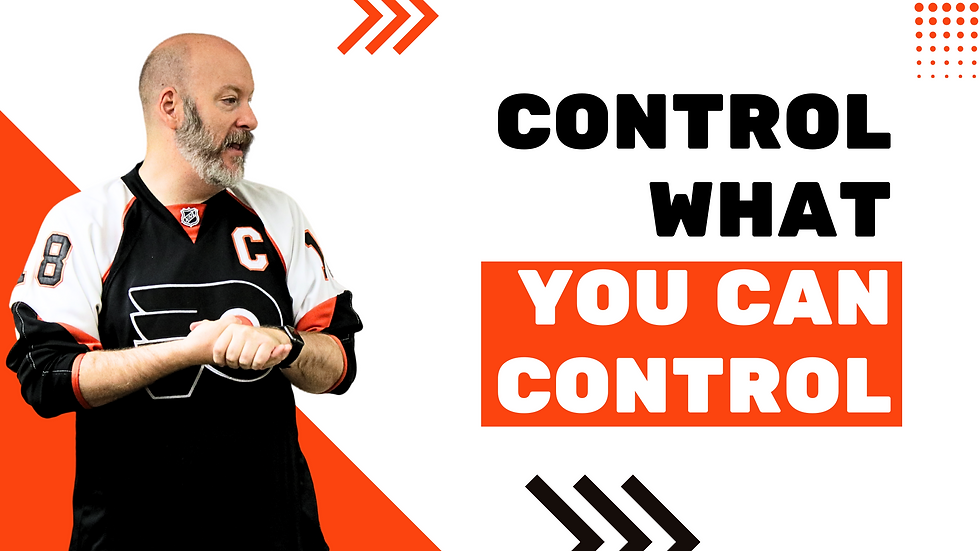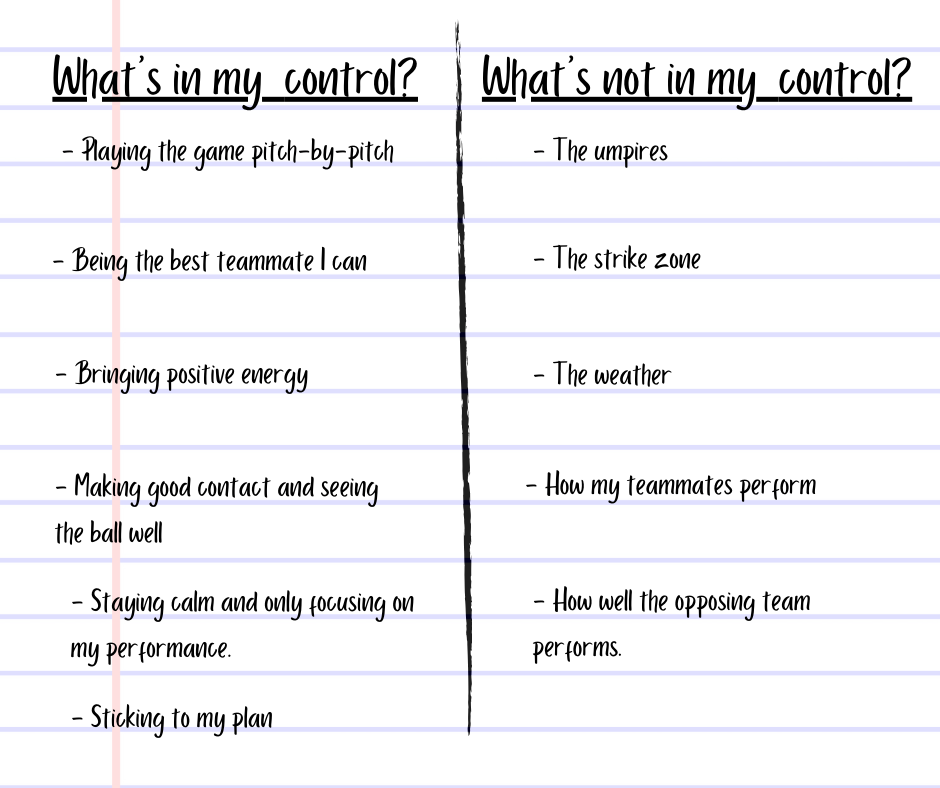Control What You Can Control - Mental Performance Coach
- Nick Carita
- Feb 13, 2024
- 6 min read
Updated: Sep 13, 2024

TABLE OF CONTENTS:
WHAT'S IN YOUR CONTROL?
If you want to live the best and most successful life you possibly can, then learning how to put “control” in its rightful place will be an essential skillset to develop.
Learning to master what is 100% in your control will help you maximize your energy and time which, in turn, will help you move closer to TAKING YOUR PLACE in this world!
We live in a time where outside influences like social media, the news, etc, show us what’s going on in the world, and it can be downright scary! Wars between countries, the current financial climate, murders in our local area, etc., can make living in our society a scary time!
Even between our ears, some of the words and phrases that we say to ourselves (self-talk) and some of the rabbit trails we allow our minds to go down (worry, doubt, etc) do not help us to stay in a positive frame of mind or to have hopes for a brighter future.
But, when you can learn to master putting into place what’s in and out of your control, you’ll open up your mind to more freeing thoughts.
There are only two things you can control in life: Your thoughts and your actions.

I want you to think about that for a moment…
What are some of the things that you have NO control over, or you don’t have 100% control over, in life?
For you personally, it could be things like
- How you are perceived by others
- The current financial climate
- The job market
- Your neighbor’s noisy dog
- Your favorite sports team’s record
- If a sales prospect says yes to your product or service
For coaches and athletes, it could be:
- The field you’re playing on
- The umpire or referees
- How good the pitcher is
- How well the goalie is playing
- How your teammates are performing
- Weather conditions
- The strike zone
Any of these situations named above cannot be CONTROLLED by you. You may be able to influence them, but you do not have 100% control over them.
One of the most important skills you need to learn in life is how to master controlling the controllables.
What are some of the things in our lives that we have 100% control over?
- How we treat others
- The attitude we bring to our jobs each day
- How we talk to ourselves
- How we interact with our coworkers
- The energy we bring wherever we go
- The focus we bring to whatever we’re doing
For coaches and athletes, we can control:
- Our thoughts before, during, and after a game
- How we perform on the field
- How we talk to our players during stressful times within the game
- How we react when the call from the umpire/ref doesn’t go our way
- How we keep ourselves calm and collected during peak pressure within our sport
- Our routines that help us stay in the present moment while we’re performing
HOW WOULD A MENTAL PERFORMANCE COACH TEACH YOU TO YOU TRAIN CONTROL?
Believe it or not, “control” is a skill that can be learned. Like anything, learning this skillset can be very difficult but, if you put the work in, you’ll master it.
Here’s a great framework from Dr Michael Gervais from Finding Mastery that you can use before you even get out of bed.
FRAMEWORK #1 - PRIMING
Create space in the morning to get VERY clear on the things that are within our control before the day becomes busy. This framework takes 60-90 seconds to complete.
STEP 1: Take one full deep breath to fill your brain full of oxygen. Start with your stomach, fill up your lungs, feel it in your upper back, and ENJOY the exhale. Make sure the exhale is a bit longer than the inhale. This signals to your brain that EVERYTHING IS OK and that you are in a safe space.
STEP 2: One thought of gratitude --- close your eyes and imagine something you’re grateful for. It could be that you have a roof over your head, that you’re healthy, that you have love in your life, or that life is currently on a good path. FEEL the feelings. Feel it in your body. Savor the thoughts in your mind. Use this feeling at any time during the day when you’re starting to fall away from being in a good mindset.
STEP 3: Set one intention ---- this isn’t about your goal for the day. It’s about how you want to feel today or setting up how you want to act. A lot of times, I set the intention of COURAGE or FOCUS, and I take a few seconds and imagine myself ACTING that way throughout the day.
If something comes to your mind about what you have to do, for the day, then decide HOW you want to be and, if you could see and feel yourself in that moment (mental imagery and mental rehearsal), that will make it even better.
STEP 4: Take your sheets off and put your feet on the ground. This is known as GROUNDING. This is PRESENT MOMENT FOCUS. This is helping neurologically telling your brain that you are PRESENT in that moment, you’re safe, you’re grateful, how you want to be, and you’re telling it that you’re about the business of being the way you want to be.
This is a fantastic way to set yourself up for success even before you’ve set foot outside of bed!
FRAMEWORK #2 - CONTROL LIST
I absolutely LOVE this framework and tell my clients and friends to use this one as well!
Here’s what I want you to do –
STEP #1 - I want you to take a piece of paper (I know… old school), and I want you to create two columns.
STEP #2 - In one column, label it “IN MY CONTROL”, and in the other column, label it “NOT IN MY CONTROL”.
Any time you come across a situation that’s causing you negative emotions or negative self-talk, I want you to come back to this paper and write down what IS in your control and what ISN’T in your control.
STEP #3 - I want you to create a sentence like the following ---- we’re going to use am example of a business owner and another example as an athlete.
BUSINESS OWNER
Let’s say a business owner is worried about the survival of their business because of the current economic climate. It’s a valid thing to worry about because the market pretty volatile out there. If they were to create their “control/not control” list, it may look something like this.

As you can see, in their “what’s not in my control” list are things like the economy, other people’s monies or decisions, and what’s happening in the environment around them.
In the “what’s in my control” column are their thoughts and their actions.
Based on those situations, here are a couple of affirmations that the business owner could use to help them stay calm and focused.
“I cannot control the economic climate, but I am scrappy and will find a way to succeed.”
OR
“I cannot control the economic climate right now, but I can do hard things. I’ve made it this far. I’m a fighter. I can endure anything. HERE WE GO!”
Now, let’s reframe an athlete’s concerns.
ATHLETE
Let’s say a baseball team is going into a BIG game, and they’re the away team.
The other team is the #1 team in their league, they have a stellar record, and they are dominant on offense.
They’ve also heard that the umpires tend to give favorable calls to the home team.
The team, or the individual players, may have a control list that looks like this:

As you can see, the things that the athlete CANNOT control are all external.
The only thing the athlete can control is their THOUGHTS and their ACTIONS.
What are the affirmations the player could say to themselves?
“I cannot control the umpire’s strike zone, but I will control my emotions if the call doesn’t go the direction I thought it should go.”
OR
“I cannot control the other team’s offensive production, but I can control how I stay locked in on defense when the ball is hit to me.”
These affirmations are CRITICAL to helping you switch your focus from what you cannot control to what you can control.
Once you have defined what is in your control for your situation, I want you to focus in and execute to the best of your ability the things that ARE in your control.
CONCLUSION
The next time you’re worried or anxious, become aware of your thoughts, create the two columns, write out what’s going on, then write your affirmations.
Remember, you can only control what’s in your control.
Now, let’s get going! Today, we dominate!



Comments